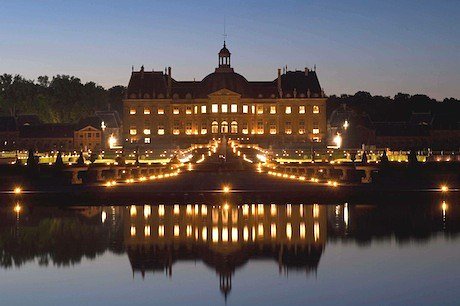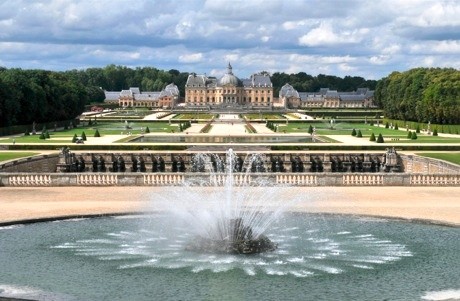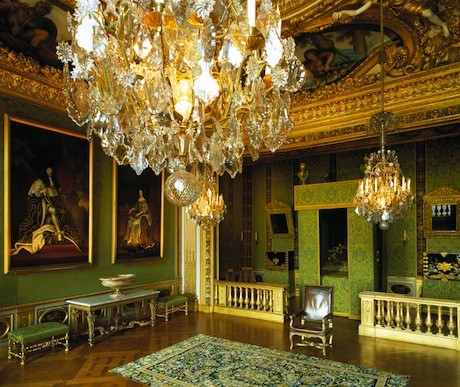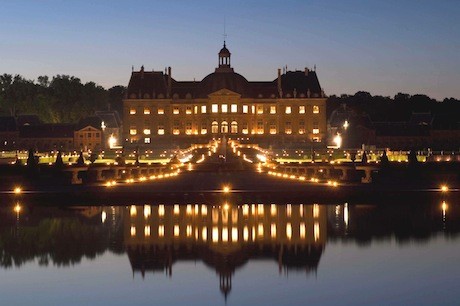Beyond Paris Tours: Château de Vaux le Vicomte

Mon 30 Sep 2013
While you’re in Paris, a day trip to one of the many nearby historic châteaux will help you discover the splendor of a bygone era of French grandeur. But I’d encourage you to look beyond the usual outside-Paris trips of Versailles and Fontainebleau, and make sure to put one hidden gem on your list: the Château de Vaux le Vicomte.

This astounding property between Paris and Fontainebleau is not only wondrous to view and trip, but it’s also rich with history. The land was acquired in 1641 by Nicolas Fouquet, minister of finance to King Louis XIV and a man who proved to be not only a young genius but a forward-thinking property owner, too. Fouquet employed the talents of the “Three Ls”—architect Louis Le Vau, interior decorator and painter Charles Le Brun, and landscape designer André Le Nôtre—to build a property brimming with creativity. He gave them three elements crucial to building an awe-inspiring property: virgin land, plenty of money and unlimited creativity. He told his designers, “Be audacious.”
The result of this brotherhood of talent is the Château de Vaux le Vicomte, a tribute to balance and the beauty of proportion. From every spot outdoors, the mansion is the eye’s anchor. From within the mansion itself, standing in the foyer, one can see a direct path from the entrance gates, through the mansion and out to the farthest point in the garden, the statue of Hercules.
When thinking of a formal French garden, many turn first to Versailles. But the fact is that André Le Nôtre’s garden at Vaux le Vicomte was the first of its kind, preceding Versailles by a decade. To stand in this spectacular garden is to witness the revolution of landscape design, as it became the model for many European gardens that followed.

But the grandeur of Fouquet’s home may have come at a terrible price. King Louis XIV, who had been steadily fed false information about Fouquet from his right-hand man Colbert (who wished to succeed Fouquet), decided to throw Fouquet in jail for an embezzlement of funds that Fouquet never committed (or at least not to the extent that Colbert accused). But he had to wait for the right moment. In August of 1661, Fouquet held a magnificent, now legendary, party to inaugurate his new home, complete with fireworks and a first-run play by Molière, and with a who’s who of French illuminati in attendance. Horrified that the home of his minister of finance was superior to his own, Louis had Fouquet thrown in jail shortly thereafter and hired the “Three Ls” to imitate Vaux le Vicomte at Versailles, only bigger and with more gold. Fouquet’s wife was sent into exile for 12 years, and the place fell into disarray, its furnishings ransacked by looters and its garden overgrown.
This is the dramatic story Alexandre Vogüé recounts as he guides me along the property. Alexandre and his twin brother, Jean-Charles, operate the grounds under the ownership of their father. Throughout the hundreds of years since Fouquet’s downfall, the property was passed down through generations, and at one point was sold at an auction where it was described as “only worth however much it will cost to destroy” the mansion and gardens. Luckily the sole bidder was Vogüé’s great-grandfather, and the family has spent the last several decades living in and passionately restoring the château to its original glory, finally opening it to the public in 1967.
Today you can see the Vaux le Vicomte as it was intended, from its opulently decorated rooms, filled with original tapestries and covered in stunningly painted ceilings, to the historic garden.

As we gazed at the garden from the back terrace of the mansion, Alexandre told me, “Most people see the garden from here and think, Oh that’s nice, now let’s go have an ice cream,” but the effect is merely a trick of the eye. In fact, there are many trompe l’oeil designs at Château de Vaux le Vicomte. Every inch is carefully crafted, a study in forced perspective. The garden seen from the mansion is designed to look compact, neat and pleasing to the eye, like a painting. But it’s meant to be traversed, explored, and as you walk away from the mansion, the garden unfurls before you, becoming seemingly larger and more open the farther you walk. There are hidden ponds, grottoes and vegetable gardens, and special picnic areas where you can bring a lunch or have one specially delivered to you right on the grass.
The Vogüés continue to improve Château de Vaux le Vicomte, making it ever-more alluring to the public—they rent out era-specific costumes for children to become a petit prince or princess for the day; they hold events celebrating 17th-Century Day and Christmas throughout the year; and every other Saturday night from May to the third Saturday in October, one can enjoy a magical candlelit evening on the property, complete with Champagne, fireworks and more than 200,000 candles illuminating the property. It’s an unmissable summer spectacle, though any time spent at Château de Vaux le Vicomte is sure to be unforgettable.
Château de Vaux le Vicomte is open for daily visits until November 11. Candlelight dinners are held every first and third Saturday of the month until October 5.
Related Link
Château de Vaux le Vicomte
Editor’s note: Girls’ Guide is going global! We are so excited about our new e-magazine, Girls’ Guide to Paris ET PLUS, we want to make sure you see it today. To experience the first issue for free, all you have to do is visit the Girls’ Guide to Paris ET PLUS subscriber page and scroll down. Enjoy it and share it with your friends—we hope you’ll become a subscriber as we travel the world together!